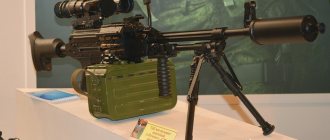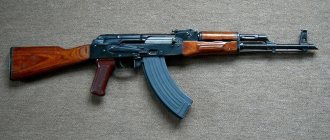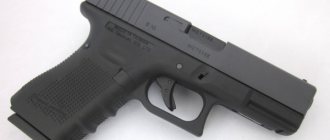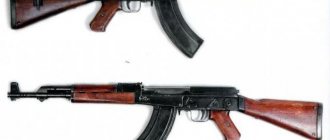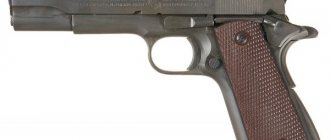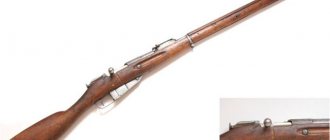Biography
Born in 1902 in the village of Kamenka, Moscow region, into a poor peasant family, he graduated from three classes of the parochial school in his village. Since 1916 he worked as a mechanic at the Kolomna Machine-Building Plant. From 1918 to 1923 he served in the Red Army, after which he continued to work at the factory.
In the winter of 1930, a military representative of the Kovrov Arms and Machine Gun Plant came to the plant. Goryunov met with him and expressed his dream of improving Maxim. The military representative wrote down his details, and soon Goryunov received an invitation to a new place of work. In March of the same year, Peter moved to Kovrov and joined the Kovrov plant as a fitter. In December 1931, he received the position of technician in the Bureau of Rationalization and Invention, and in February 1933, he moved to the experimental workshop of the plant as a mechanic-debugger.
Another designer, hitherto unknown, announced himself. He was Pyotr Maksimovich Goryunov, who worked at the Kovrov plant. He was not young, he worked with us for fifteen years, he was known as an amazing craftsman, but he never showed himself either as an inventor or as a designer.
And suddenly one day, just before dawn, Goryunov comes to me with a large package. This was the summer of 1942.
— Vasily Alekseevich, look at the model of my machine gun. I’ve been going to see you many times, but I’ve always felt ashamed.
I examined Goryunov’s model and, I admit, I couldn’t believe my eyes. The model was conceived taking into account the latest achievements in weapon automation.
- When did you do this, Maksimych? - I asked.
“I’ve been thinking about it for a long time, but I assembled the model recently, when I heard that we were given the task of creating a new heavy machine gun.
— V. A. Degtyarev
The machine gun machine was developed by V. A. Degtyarev. By Decree of the State Defense Committee of the USSR No. 3575 of June 16, 1943, the 7.62-mm heavy machine gun of the Goryunov system of the 1943 model (SG) on a wheeled machine designed by Degtyarev was adopted by the Red Army.
Pyotr Maksimovich died on December 23, 1943, returning from Moscow, where he was debugging his machine guns before being sent to the front. He was buried in Kovrov.
In 1946, Goryunov, along with other designers who took part in the development of the SG-43, was posthumously awarded the Stalin Prize.
Creators of small arms: Goryunov P.M., Voronkov V.E., Goryunov M.M.
At the plant named after Kirkizha (now the plant named after V.A. Degtyarev) during the war years a whole galaxy of outstanding small arms designers worked. Among them is our fellow countryman Vasily Efimovich VORONKOV, a native of the village of Semenigino. In a group with Pyotr Maksimovich and Mikhail Mikhailovich Goryunov, he worked on the creation of the SG-43 heavy machine gun.
“Tests of the Goryunov machine gun were already in full swing, which showed its undeniable advantages over other systems, including the Degtyarev heavy machine gun, and Stalin still believed that in any case it was the Degtyarev model that should be taken as a basis. At the beginning of April 1943, at one of the meetings, he confirmed his point of view...
Tests carried out in early May 1943 confirmed the correctness of those who stood for the P.M. heavy machine gun. Goryunova. The commission's conclusions did not correspond to Stalin's opinion. Having familiarized himself with the test act, he convened a meeting of the heads of the People's Commissariats of Defense and Armaments, where he invited V.A. Degtyareva. After the relevant documents were read out, Stalin asked Vasily Alekseevich:
- What do you think about this, Comrade Degtyarev? Which machine gun do you think should be adopted – yours or the one designed by Goryunov?
With characteristic directness and sense of duty, Vasily Alekseevich answered:
“The Goryunov machine gun is better, Comrade Stalin, and industry will master it faster.”[1]
The first SG-43 machine guns were sent to the front in October 1943. Our soldiers immediately liked it, as it was simple in design, reliable and quickly transferred to a position for firing at air targets. One of the reports sent from the front to the Main Artillery Directorate said this about the Goryunov machine gun: “The simplicity of its design makes it trouble-free, capable of quickly changing firing positions with the least amount of energy. The presence of a metal tape makes it possible to quickly and under any weather conditions fill it with cartridges. The use of the Maxim machine gun belt is also a positive quality. Air cooling of the machine gun simplifies preparation for shooting.” The production of machine guns was mastered in Kovrov and Zlatoust, which contributed to the final solution to the problem of supplying troops with machine guns and the creation of reserves, which by the end of 1944 amounted to 74,000 units.
Pyotr Maksimovich Goryunov (1901 - 1943) was born in the Moscow region, in the village of Kamenka, Kolomna district, into a peasant family. He was only able to finish third grade and was forced to go to work. In his profiles and characteristics until the end of his life, the lines remained: “Non-party, low education.”
Since 1916 P.M. Goryunov worked as a mechanic at the Kolomna Machine-Building Plant, then served in the Red Army and returned to the plant again. And in March 1930 he moved to Kovrov and entered the tool factory No. 2 as a fitter. In February 1933, Pyotr Maksimovich moved to the experimental workshop of the bureau of new designs. Working as a mechanic-debugger together with V.A. Degtyarev and G.S. Shpagin, participating in the assembly and testing of new weapons, he himself grew into a designer-inventor.
The wooden model of a light machine gun he made was approved by the People's Commissar of Armaments in 1940 as a model for further work. And although the GVG machine gun (Vasily Efimovich Voronkov and Mikhail Mikhailovich Goryunov, the nephew of the inventor, also participated in the work on it) was not adopted for service, Pyotr Maksimovich, as an active inventor, was awarded the Order of the Badge of Honor in January 1942, and he himself The sample served as the basis for further work on the SG-43 heavy machine gun.
At the end of December 1943, Pyotr Maksimovich Goryunov was buried with full honors in the cemetery behind the Murom road (at that time it was also called the “new city cemetery”). The obituary was signed by D.F. Ustinov and other leaders of the People's Commissariat of Armaments, Deputy People's Commissar Barsukov came to the funeral, a special resolution was adopted by the Council of People's Commissars of the USSR... And in 1946 the name of P.M. Goryunova (posthumously) appeared on the list of those awarded the Stalin Prize.
“It is noteworthy that the Bureau of Inventions of the USSR State Planning Committee did not recognize the design of the machine gun as an invention.
This may be due to the fact that the application materials did not clearly outline the differences between the new machine gun and the existing ones. In any case, the provisions set out in the decision of the Bureau of Inventions could easily be refuted. However, the authors did not enter into controversy. To mark the authors of the machine gun, the People's Commissariat decided to extradite P.M. Goryunov, V.E. Voronkov and M.M. Goryunov received an author’s certificate for the design of the 7.62 mm “SG” heavy machine gun, qualifying this proposal as a technical improvement.” [2]
Vasily Efimovich Voronkov (1899-1976) was born in the village of Semenigino, Kameshkovsky district, Vladimir region, into a poor peasant family. At the age of 13, having completed three classes of a rural school, he entered the Kochetkov factory (now the Volodarsky factory) in the village of Vakhromeevo in the same region, where he worked as an oiler, fireman, hammer hammer, and electrician. In 1919 he moved to the city of Kovrov and entered the arms and machine gun factory, from where he was soon drafted into the ranks of the Red Army.
After demobilization from the army in 1922, he returned to his factory, where, before retiring in 1960, he successively worked his way up from mechanic to designer-inventor (1942), senior engineer (1946) and research engineer (1954). G.).
For the work on creating the heavy machine gun V.E. Voronkov was awarded the USSR State Prize, he was awarded the Order of the Red Banner of Labor and medals. After the end of the Great Patriotic War, in connection with the plant’s transition to producing civilian products, he began designing motorcycles. Among his most successful developments in this area is the three-wheeled cargo motorcycle he created (1958).
Goryunov Mikhail Mikhailovich (1912–1991) was born in the village of Kamenka, Kolomna district, Moscow province. Received primary education. Since 1930 he worked in Kolomna as a mechanic. In 1934 – 1982 worked in Kovrov at the plant named after. Degtyarev (after the reorganization and division of enterprises - into OKB-575 - KB "Armatura"), went from mechanic to designer, workshop manager and deputy. head of pilot production. Participated in the development of the 7.62 mm SG-43 machine gun under the leadership of P.M. Goryunov and other types of small arms. Awarded the Order of the Red Banner of Labor, laureate of the USSR State Prize (1946), nephew of P.M. Goryunova.
S.B. Kudryashova
[1]From the book by V.N. Novikov. On the eve and on the days of testing. Memories. M., 1988.
[2] From the book Rusakov O.S. Kovrov gunsmiths. M., 1995.
Shpitalny, Vladimirov and Serdyukov: unknown “fathers” of famous weapons
Since 2010, on September 19, Russia has celebrated Gunsmith's Day - a professional holiday for workers of defense enterprises. According to one version, Mikhail Kalashnikov asked the Russian President for “his” celebration.
History knows many names besides the “father” of the most famous machine gun, but even more surnames are hidden - due to modesty, weapons or twists of fate not very well known to a wide circle. The m24.ru columnist recalls 10 such designers who changed the world in their own way.
Photo: m24.ru/Alexander Avilov
Petr Goryunov
In 1930, Peter, who served for five years in the Red Army as a machine gunner, was working as a mechanic at the Kolomna Locomotive Plant when a representative of the Kovrov Arms and Machine Gun Plant (now the Degtyarev Plant) came to them. Goryunov, who had first-hand knowledge of the Maxim machine gun and its shortcomings, told the guest about his ideas for improving the weapon.
Photo: russianguns.ru
The representative listened and wrote down his data, and later the savvy mechanic was called to work as a technician in Kovrov under the leadership of Vladimir Fedorov (who will be discussed below). A year later, Goryunov moved to an experimental workshop under the supervision of Degtyarev himself, the creator of a series of machine guns and anti-tank rifles.
Degtyarev himself said that one day master Goryunov came to him - according to reviews, a good specialist, but not an inventor, and proposed a new model of a machine gun, later called SG-43. After modifications, the weapon was put into service - the year was 1942 and the army needed lighter machine guns to replace the heavy “Maxims” (SG-43, together with the wheeled machine, weighs 37 kilograms versus 70 for the “Maxim”).
Photo: warbook.info
In total, 80 thousand of these machine guns were delivered to the army before the end of the war; their production was closed only in 1961; in particular, the weapon was modernized and installed on the BRDM-1. For the creation of the SG-43, Goryunov received the Stalin Prize. The designer died in 1943, when he returned from Moscow, where he was debugging the SG before being sent to the front.
Vladimir Fedorov
In 1897, Vladimir Fedorov, a graduate of the Mikhailovsky Artillery Academy, entered the Sestroretsk plant for practical training. There he met the creator of the three-line rifle, Mosin. After practice, Fedorov went to serve in the Main Artillery Directorate.
In this position, Fedorov was haunted by the three-ruler, and he set about improving it, turning it into an automatic one. In total, at that time there were about 4 million Mosinki in the army, and it was easier to remake them than to launch production of a fundamentally new design.
The caliber of the new rifle remained the same, but Fedorov came up with his own cartridge - 6.5 mm, which became the world's first intermediate ammunition (average in power between pistol and machine gun). Fedorov needed the ammunition for a “machine gun,” as he dubbed the machine gun.
In 1916, the artillery department placed an order for 25 thousand machine guns at the Sestroretsk plant, but wartime made its own adjustments and the order was reduced to 9 thousand, and then completely withdrawn. However, Fedorov continued the work: together with Degtyarev, Shpagin and Simonov, he developed PPSh assault rifles, which became one of the symbols of victory in the Great Patriotic War.
Vasily Gryazev
Vasily Gryazev was born in the city of gunsmiths - Tula, and in 1945 he entered the weapons and machine gun department of the Mechanical Institute. After graduation, Gryazev was sent to practice in Podolsk, at the Research Institute of Precision Engineering (TsNIITochmash), where he was supposed to work on aviation cannon armament.
The employee who decided to send Gryazev there was right: in 16 years, the designer turned from a trainee to a chief designer. Then Gryazev was called back to Tula by another designer, Shipunov, and together they began working on automatic weapons.
Their first joint development was the GSh-23, a double-barreled aircraft cannon. It was installed on fighters, transport aircraft, interceptors, attack aircraft and helicopters. The widespread use of Soviet technology - from Vietnam to Cuba - led to the fact that the GSh-23 literally traveled all over the world. Nowadays the cannon can be seen on the tail of the Il-76M transport aircraft or on the Mi-24 helicopter.
On the right side of the helicopter is a twin GSh-23. Photo: TASS/Press service of OJSC Rosvertol
Among Gryazev’s other developments are the six-barreled GSh-6 cannon (in Russia this form factor is often called a “minigun”), the high-speed double-barreled GSh-30 and even the 100-mm 2A70, which is installed on modern infantry fighting vehicles, armored personnel carriers and infantry fighting vehicles.
Arkady Shipunov
Speaking about Gryazev, one cannot fail to mention Arkady Shipunov, co-author of many developments in the field of aviation artillery. In 1950, Shipunov graduated with honors from the Tula Mechanical Institute with a degree in rifle and artillery systems and installations, and then moved to Klimovsk near Moscow, where he worked at TsNIITochmash. There he became deputy chief engineer.
12 years after graduation, Shipunov headed the Tula TsKB-14, which was later transformed into the Instrument Design Bureau, where Gryazev later came.
In the sixties, cannon weapons were replaced by missile weapons, and Shipunov was entrusted with working in a new direction. In particular, the anti-tank “Fagot”, a system for launching guided projectiles from the barrel of a tank gun and the mobile air defense system “Pantsir-S1” can be attributed to him - in total, Shipunov has 772 inventions.
In addition, in collaboration with Gryazev, Shipunov developed the GSh-18 pistol, which penetrates any body armor, the Shmel flamethrowers, and the world’s first portable missile defense systems, Igla-S.
"Igla-S". Photo: TASS/Yuri Smityuk
Boris Shpitalny
In 1919, Boris Shpitalny began working as an assistant driver on the Northern Railway. In 1921-1922 he was a mechanic at the Mytishchi Carriage Plant, and in 1923 he moved to the laboratory of hydraulic installations at the Timiryazev Agricultural Academy. Simultaneously with his work, Boris studied at the Moscow Mechanical Institute at the Department of Aviation Engineering, and even then he set out to create a high-speed machine gun.
It is worth making a disclaimer: we are talking about the late 20s, when Soviet aircraft needed to increase their firepower in response to the developments of a potential enemy. At that time, fighters carried the ubiquitous Maxims, but the Air Force needed a higher rate of fire coupled with a new cartridge - the old one, if used in high-speed machine guns, could get stuck. After graduating from the institute, Shpitalny moved to the Scientific Automotive Institute, from where he ended up in the design bureau of the Tula Arms Plant. There, in 1930, he assembled the first sample of a rapid-fire machine gun, which he then brought to mind together with his colleague, Irinarkh Komaritsky.
In 1932, the designers showed the weapon to the People's Commissariat of Defense; Voroshilov was present at the acceptance, who, as eyewitnesses recall, was amazed - the new machine gun, named after its creators ShKAS (Shpitalny-Komaritsky aviation rapid-fire), could fire 1200-1800 rounds per minute versus 1000 -1200 for English and German.
Photo: snariad.ru
In those years, industry was moving by leaps and bounds, and already in 1937 the Air Force needed faster-firing weapons. Then Shpitalny showed the “ultraShKAS”, which fired at a speed of 3000 bullets per minute, but pairing two old ShKAS, which were installed on fighters, became much more reliable.
Later, designers, responding to the challenge of the time, developed a large-caliber ShVAK machine gun, from which they made a 20-mm aircraft cannon (the first in the history of Soviet aviation); it was even installed on tanks, for example, the T-30. ShVAK guns became the most widespread model of aviation weapons of the Great Patriotic War.
T-30 tank with ShVAK cannon
Shpitalny's latest creation in the field of aviation weapons was a 57-mm cannon (the caliber is comparable to light anti-tank guns), but it remained in the drawings.
Irinarch Komaritsky
Komaritsky’s first serious work was his participation in the modernization of the famous three-line rifle of the 1891 model, or “Mosinki”, namely, he changed the way the bayonet was attached. Previously, the bayonet was attached using a turning clamp, which quickly became loose, but Komaritsky replaced the clamp with a spring latch. After this modification, the weapon received the name “7.62 mm rifle model 1891/1930.”
In addition, Komaritsky created a 37-mm landing gun of the Cheka. Stalin personally supervised the work on the weapon, and he was also reported on the progress of the tests. In total, about 500 guns were fired during the Second World War. In addition to landing, the guns could be mounted on SUVs like the Willys and on motorcycles, turning both into light anti-tank self-propelled guns.
However, the ShKAS machine gun brought Komaritsky the greatest fame, and his achievements include the establishment of mass production.
Semyon Vladimirov
Semyon Vladimirov worked as a mechanic at a weaving and spinning factory in Yaroslavl, at factories in Petrograd, and in the mines of Siberia as a fitter, mechanic and design technician.
In 1919, Vladimirov was mobilized into a partisan detachment in Altai, where he first became acquainted with automatic weapons, and so well that he organized a repair shop there.
Later, Semyon Vladimirov was in charge of the fortress searchlight station in Sevastopol, and with the end of the war, he was demobilized and moved to Tula, where he accepted the position of mechanic. After some time, he became a senior design engineer at TsKB-15, where in 1930, in order to unify the machines for the Maxim machine gun, he created a new wheeled tripod machine.
Real fame came to Vladimirov thanks to his work on the ShVAK (Shpitalny-Vladimirov) machine gun, converted into a cannon.
However, the experience of the war showed that both aviation and infantry needed weapons more powerful than the 12.7-mm DShK heavy machine gun then in service. By that time, the USSR had a 14.5 mm cartridge used in anti-tank rifles, and it was this that Vladimirov used for the new weapon. In 1944, the KPV-44 was born, an almost 40-kilogram machine gun with a rate of fire of 500-550 rounds per minute.
When firing at a distance of up to 500 meters, the KPV penetrated armor 32 millimeters thick, and it was adopted not only as an infantry weapon, but also as an air defense weapon.
Photo: topwar.ru
Later, a tank version was developed - the 14.5-mm Vladimirov tank machine gun (KPVT), which was installed in tank turrets and is still installed in armored personnel carriers. The KPVT is considered one of the most powerful serial machine guns.
Armored personnel carrier of the capital's riot police with KPVT. Photo: m24.ru/Alexander Avilov
Valery Telesh
Valery Telesh began working at the TsKIB of sporting and hunting weapons in Tula as an assistant to famous designers, but later he went into a very narrow industry - the design and manufacture of grenade launchers, which brought him fame.
At that time, motorized rifle units had a 30-mm AGS-17 “Plamya” grenade launcher, which weighed about 30 kilograms, which, of course, is a lot for one person, and in general, the large weight of an essentially individual weapon broke all the standards of motorized rifle units.
Photo: TASS/Sergey Bobylev
Telesh decided to develop a lighter, but more powerful weapon for a 40-mm shellless grenade. It is worth noting that such ammunition - without a cartridge case - simplifies the design of the weapon, because there is no need to introduce a system for its ejection. The result of Telesh’s work was the 16-kilogram “Kozlik”. The designer did not stop there and developed the “Balkan” - essentially the same “Kozlik”, but on a machine and with a seat for the shooter. However, Telesh has more famous products - in particular, he came up with the idea of GP-25, the first under-barrel grenade launcher, and the 6G30 revolver. The designer can also be called the “father” of one of the most controversial weapons – the Groza rifle complex.
"Storm". Photo: m24.ru/Alexander Avilov
Petr Serdyukov
After graduating from university, Petr Serdyukov entered TsNIITochmash as a design engineer, where he worked as an assistant to the famous gunsmith Sergei Simonov (author of the SKS carbine) on the design of a new self-loading sniper rifle.
There he also took part in the development of the SPP-1 underwater pistol, and developments in the field of weapons for swimmers helped him create the first double-medium assault rifle - the APS. Now the assault rifle can only be seen in a museum, but other developments of Serdyukov are still in use today - we are talking about a shooting complex for special forces, which consists of a Val assault rifle and a Vintorez sniper rifle.
"Vintorez" on the left. Photo: m24.ru/Alexander Avilov
Before the creation of the complex, special forces units had modified weapons - for example, complexes of silencers and sights for AKM and AKS74U. However, this solution had disadvantages - in particular, a decrease in effective firing range and a limited resource.
Therefore, TsNIITochmash, under the leadership of the KGB, decided to create special types of weapons that were supposed to solve narrowly targeted tasks. As a result, Serdyukov, together with his colleagues, developed “Val” and “Vintorez”, which were adopted back in the 80s and are still in use today.
The complex has an analogue - this is the Vykhlop sniper rifle and the ASH-12 assault rifle, they are made according to the bullpup design (a layout in which the magazine is moved back, behind the trigger) and are in service with the FSB special forces.
Yuri Danilov
In 1975, the APS assault rifle, a weapon designed for submariners, was adopted. It can shoot both underwater and in the air, and a special needle cartridge has been developed for it.
However, shooting from the APS outside the water was not very effective, so swimmers had to take regular AKs with them. Then Tula gunsmiths were asked to develop a double-medium weapon, and Yuri Danilov got down to business.
Automatic APS. Photo: TASS/Sergey Savostyanov
Weapon designer Yuri Danilov graduated from the Tambov Artillery School and the Penza Higher Artillery School, after which he was appointed a teacher at the Tula Engineering School (TAII, Tula Engineering Artillery Institute), where he organized a laboratory for testing underwater weapons. Thus, under the leadership of Danilov, MSP and S4M pistols were redesigned for swimmers.
Based on the APS, Danilov developed the “Sea Lion” - a double-medium assault rifle that could fire both special ammunition and standard 5.45 caliber ammunition (like the AKS74U). In addition, the APS was “dressed up”: a sight, a bayonet, a grenade launcher, a laser sight and a device for silent and flameless shooting were hung on it. Based on the “lion”, an ADS assault rifle was made, which is used by combat swimmers today.
ADS. Photo: wikimedia.org/Vitaly Kuzmin
Since 2001, Danilov has been retired, but continues to teach at TAII.
